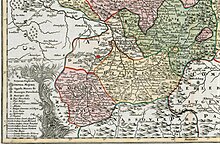Waldenburg Office
The Waldenburg Office was an administrative unit in the Duchy of Westphalia . Its creation can be traced back to the early 14th century. It was often administered together with the Bilstein Office. In 1807 it was dissolved and merged with the newly founded Amt Olpe .
history
The office goes back to a rulership of the same name based on the Waldenburg near Attendorn . The castle and the lordship came into the possession of the Cologne Archbishopric in 1248 through purchase . Archbishop Konrad von Hochstaden appointed a drosten or bailiff . When, after the lost battle of Worringen in 1288, the ownership of Waldenburg was questioned by the Counts of the Mark , the Marshal of Westphalia Johann I von Plettenberg had Schnellenberg Castle built in this area to support Cologne's rule . At the beginning of the 14th century, the Cologne possessions in this area were combined to form the Waldenburg Office. In 1356 the castles Waldenburg and Schnellenberg as well as the towns of Olpe and Attendorn belonged to the office.
The area was initially isolated between the estates of foreign masters. Even if it initially belonged to the Marshal's office of Westphalia, the archbishops reserved the right to appoint the bailiffs themselves, while the marshal did this in the other offices. Within the office, approaches to a self-image developed. By the 1370s at the latest, it was no longer an integral part of the Marshal's Office. The area remained under the marshals' jurisdiction only indirectly, in particular through its military protective function. The archbishops tried to remedy this temporarily by giving the marshal's office and the Waldenburg office to one person. The relative independence was also shown by the fact that in 1462 the knights, cities and freedoms of the office were united.
However, the territorial isolation of the office was lifted through the acquisition of the county of Arnsberg (1368) and the rule of Fredeburg-Bilstein (1444/45). This made it easier to integrate into the late medieval and early modern duchy of Westphalia. From then on, the office was so often associated with the offices of Bilstein and Fredeburg that his name temporarily disappeared from the sources. In contrast to the Bilstein office, for example, it does not appear as an independent office in the treasury registers of the 16th century. For a long time it was also united with the office of Schönholthausen .
1556 appointed Elector Adolf von Schaumburg to Friedrich von Furstenberg (Drost) to Drost of offices and Bilstein Waldenburg and entrusted him in addition to the management of the Office Fredeburg .
literature
- Wilhelm Jansen: Marshal Office Westphalia - Office Waldenburg - County Arnsberg - Dominion Bilstein-Fredeburg: The emergence of the territory of the Duchy of Westphalia. In: Harm Klueting (Ed.): The Duchy of Westphalia. Volume I: The Electorate of Cologne Duchy of Westphalia from the beginnings of Cologne rule in southern Westphalia to secularization in 1803. Aschendorff, Münster 2009, ISBN 978-3-402-12827-5 , pp. 235-267.
- Willi Voss: Waldenburg Office. Parish of Schönholthausen. Courtyards in the parish of Schönholthausen. 1940. Completed in 2012 by Pastor Franz Rinschen. Edited by Robert J. Sasse ( heimatbund-finnentrop.de ( memento from March 6, 2017 in the Internet Archive ) [PDF; 1.4 MB]).
- Homeland papers. Journal of the local associations of the Olpe district. Volume 5 + 6 (1927 / 28–1928 / 29), ZDB -ID 500819-0 , years 11–18 (1936–1941), ZDB -ID 500823-2 (predecessor of the Heimatstimmen from the Olpe district ).
- Manfred Schöne: The Duchy of Westphalia under Hesse-Darmstadt rule 1802–1816 (= regional history series for the Sauerland in Cologne. Issue 1). Olpe 1966, DNB 458875309 (Bonn, Philosophical Faculty, Diss., 1965, DNB 481222081 ).
- Elisabeth Schumacher: Cologne's Westphalia in the Age of Enlightenment with special consideration of the reforms of the last elector of Cologne, Max Franz of Austria (= regional history series for the Cologne Sauerland. Issue 2). Olpe 1967, DNB 458907111 (Bonn, Philosophical Faculty, Diss., 1952, DNB 480266999 ).
Individual evidence
- ^ Wilhelm Jansen: Marshal Office Westphalia - Office Waldenburg - County Arnsberg - Dominion Bilstein-Fredeburg: The emergence of the territory of the Duchy of Westphalia. In: Harm Klueting (Ed.): The Duchy of Westphalia. Volume I: The Electorate of Cologne Duchy of Westphalia from the beginnings of Cologne rule in southern Westphalia to secularization in 1803. Aschendorff, Münster 2009, ISBN 978-3-402-12827-5 , pp. 235-267.
